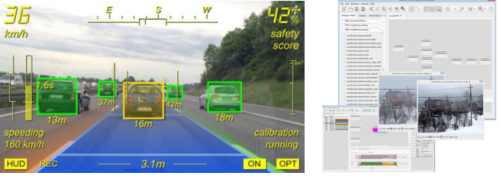In the past, people thought that the concept of “unmanned driving†and “machine driver liberating human drivers†was far from satisfactory. However, Intel is letting such an idea fall. In order to drive the data center on the wheel, Intel's current power in the field of unmanned driving is described as "not a thousand miles". The six technologies are "steps" and help others. The key to driving a car is a thousand miles.
What is most important when we are driving?
driving skills? Car performance? No, it’s a pair of eyes.
When driving, the driver mainly looks at the road through his eyes, and then quickly makes decisions and makes decisions through the brain. With the advent of the era of automatic driving, the “machine driver†will import and update the collected massive data into the high-precision map in real time, and then make judgments through big data and machine learning. Therefore, the high-precision map can take all the road conditions to the "eye" and tell the vehicle, where I am, what the surrounding environment is, and how to plan the route to the destination.
The high-precision map is crucial for the navigation, positioning, path planning and control of unmanned vehicles, which directly affects the efficiency and safety of the vehicle. The high-precision map jointly developed by Intel and HERE is the key to real-time insight into road conditions and timely decision-making of unmanned vehicles.

HERE HD real-time maps leverage big data and machine learning to deliver highly accurate and up-to-date information
Machine-readable real-time maps for driverless cars to predict corners and front road conditions
Unlike the maps we see every day, the machine reads a layered map—on the ground floor, you can identify the main road network, lane lines, altitude, and surrounding street lights or road signs. At the top is the machine map. In the case of repair, at this stage, the HD Map becomes a Sensor Map, because every driverless car captures new data while driving and calculates it by means of images. After the quick analysis, the change of the road ahead can be identified, and finally the correction is made and the data is transmitted back to the unmanned vehicle. In this gradual process, Intel's efforts in the field of high-precision maps will drive unmanned driving to the fast lane. In turn, the escalation of unmanned sub-sectors will also feed on high-precision maps.
Cloud-based reference model for real-time comparison of sensor data with vehicle surroundings
In the high-level scene of unmanned driving, there will be dynamic maps in the cloud and short-term static maps in the car. When the driverless vehicle is driving, the images captured by the sensor and the camera in real time are compared with the dynamic map of the cloud. All changes in the road ahead will be captured and fed back to the cloud. After collection and refinement, the short-term static map of the vehicle will be corrected. This is a process from dynamic to static cycle, and the upgrade is revised. It can be said that this is a key point in the current climb of the unmanned peak, because it means the collection of a large number of road conditions data, and the classification and calibration of the data. In the early days, the coffee shops, gas stations, etc. displayed on the map were all manually calibrated, but once they entered the high-precision map stage, it was difficult for people to load such massive data, and more vividly, the personnel of the high-definition map. The configuration requires only 100 people, and in traditional maps, the number of people to be calibrated ranges from 2,400 to 2,500.
Take advantage of big data and machine learning to provide cars with highly accurate first-hand information
Machine learning is an all-encompassing, all-encompassing area where real-time traffic is a classic and easy-to-understand key point. Real-time traffic does not simply identify the traffic conditions that have occurred on a particular road segment, and then sends this information to each unmanned vehicle. In fact, real-time traffic is to put historical data together with the current overall road network data, and make predictions through machine learning. In addition, machine vision is also used around the vehicle. Although most of the models have been trained, if a person suddenly runs in front of the car and has a running speed that exceeds the average, the sample will be used as a special case. Go back to the server and create a new sample to identify all extremes and be foolproof. Powerful machine learning will be at this stage.
Not only are the technical points of the high-precision map interlocking and advancing each other, but also the relationship between the high-precision map and the driverless, because once the high-definition map is lost, path planning, self-positioning and other actions will not be realized. If you want to use a pair of "invisible hands" to turn the steering wheel of an unmanned vehicle, the high-precision map developed by Intel and HERE is an indispensable power-assisting technology.
Flexible Led Screen,Small Flexible Led Screen,Flexible Led Stage Screens,Bendable Led Screen
Shenzhen Apexls Optoelectronic Co., Ltd , http://www.apexls-display.com